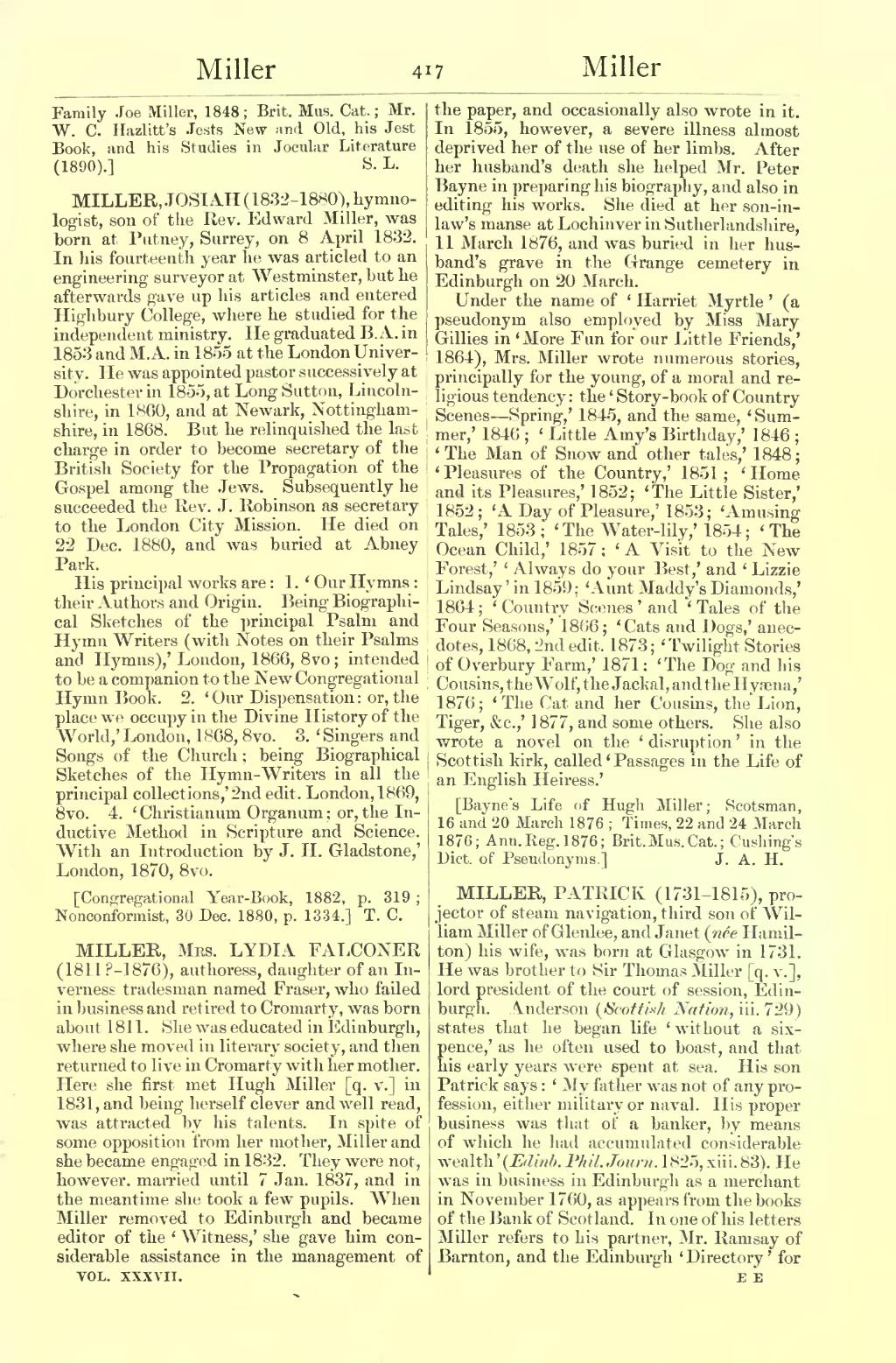MILLER, JOSIAH (1832–1880), hymnologist, son of the Rev. Edward Miller, was born at Putney, Surrey, on 8 April 1832. In his fourteenth year he was articled to an engineering surveyor at Westminster, but he afterwards gave up his articles and entered Highbury College, where he studied for the independent ministry. He graduated B.A. in 1853 and M.A. in 1855 at the London University. He was appointed pastor successively at Dorchester in 1855, at Long Sutton, Lincolnshire, in 1860, and at Newark, Nottinghamshire, in 1868. But he relinquished the last charge in order to become secretary of the British Society for the Propagation of the Gospel among the Jews. Subsequently he succeeded the Rev. J. Robinson as secretary to the London City Mission. He died on 22 Dec. 1880, and was buried at Abney Park.
His principal works are:
- ‘Our Hymns: their Authors and Origin. Being Biographical Sketches of the principal Psalm and Hymn Writers (with Notes on their Psalms and Hymns),’ London, 1866, 8vo; intended to be a companion to the New Congregational Hymn Book.
- ‘Our Dispensation: or, the place we occupy in the Divine History of the World,’ London, 1868, 8vo.
- ‘Singers and Songs of the Church; being Biographical Sketches of the Hymn-Writers in all the principal collections,’ 2nd edit. London, 1869, 8vo.
- ‘Christianum Organum; or, the Inductive Method in Scripture and Science. With an Introduction by J. H. Gladstone,’ London, 1870, 8vo.
[Congregational Year-Book, 1882, p. 319; Nonconformist, 30 Dec. 1880, p. 1334.]
MILLER, Mrs. LYDIA FALCONER (1811?–1876), authoress, daughter of an Inverness tradesman named Fraser, who failed in business and retired to Cromarty, was born about 1811. She was educated in Edinburgh, where she moved in literary society, and then returned to live in Cromarty with her mother. Here she first met Hugh Miller [q. v.] in 1831, and being herself clever and well read, was attracted by his talents. In spite of some opposition from her mother, Miller and she became engaged in 1832. They were not, however, married until 7 Jan. 1837, and in the meantime she took a few pupils. When Miller removed to Edinburgh and became editor of the ‘Witness,’ she gave him considerable assistance in the management of the paper, and occasionally also wrote in it. It 1855, however, a severe illness almost deprived her of the use of her limbs. After her husband's death she helped Mr. Peter Bayne in preparing his biography, and also in editing his works. She died at her son-in-law's manse at Lochinver in Sutherlandshire, 11 March 1876, and was buried in her husband's grave in the Grange cemetery in Edinburgh on 20 March. Under the name of ‘Harriet Myrtle’ (a pseudonym also employed by Miss Mary Gillies in ‘More Fun for our Little Friends,’ 1864), Mrs. Miller wrote numerous stories, principally for the young, of a moral and religious tendency: the ‘Story-book of Country Scenes—Spring,’ 1845, and the same, ‘Summer,’ 1846; ‘Little Amy's Birthday,’ 1846; ‘The Man of Snow and other tales,’ 1848; ‘Pleasures of the Country,’ 1851; ‘Home and its Pleasures,’ 1852; ‘The Little Sister,’ 1852; ‘A Day of Pleasure,’ 1853; ‘Amusing Tales,’ 1853; ‘The Water-lily,’ 1854; ‘The Ocean Child,’ 1857; ‘A Visit to the New Forest,’ ‘Always do your Best,’ and ‘Lizzie Lindsay’ in 1859; ‘Aunt Maddy's Diamonds,’ 1864; ‘Country Scenes’ and ‘Tales of the Four Seasons,’ 1866; ‘Cats and Dogs,’ anecdotes, 1868, 2nd edit. 1873; ‘Twilight Stories of Overbury Farm,’ 1871; ‘The Dog and his Cousins, the Wolf, the Jackal, and the Hyæna,’ 1876; ‘The Cat and her Cousins, the Lion, Tiger, &c.,’ 1877, and some others. She also wrote a novel on the ‘disruption’ in the Scottish kirk, called ‘Passages in the Life of an English Heiress.’
[Bayne's Life of Hugh Miller; Scotsman, 16 and 20 March 1876; Times, 22 and 24 March 1876; Ann. Reg. 1876; Brit. Mus. Cat.; Hamst's Fictitious Names, pp. 84, 90; Cushing's Dict. of Pseudonyms.]
MILLER, PATRICK (1731–1815), projector of steam navigation, third son of William Miller of Glenlee, and Janet (née Hamilton) his wife, was born at Glasgow in 1731. He was brother to Sir Thomas Miller [q. v.], lord president of the court of session, Edinburgh. Anderson (Scottish Nation, iii. 729) states that he began life ‘without a sixpence,’ as he often used to boast, and that his early years were spent at sea. His son Patrick says: ‘My father was not of any profession, either military or naval. His proper business was that of a banker, by means of which he had accumulated considerable wealth’ (Edinb. Phil. Journ. 1825, xiii. 83). He was in business in Edinburgh as a merchant in November 1760, as appears from the books of the Bank of Scotland. In one of his letters Miller refers to his partner, Mr. Ramsay of Barnton, and the Edinburgh ‘Directory’ for
